The Benedictine labazia of Santa Maria di Moie constitutes one of the most interesting examples of Romanesque architecture in the Marche region and is located in the homonymous town in the province of Ancona (fig.1), strategically located because it is near the road connecting lUmbria with the Adriatic coast through the dellEsino valley. In 1923 the church was declared a national monument. Labbazia was probably founded in theXI century by members or relatives of the Attoni-Alberici-Gozoni family as a private monastery: this family dominated at that time all the central Marche region and sought to consolidate its political and economic power through the foundation of private monasteries in the most strategic places in the region (San Vittore delle Chiuse in the municipality of Genga and probably Santa Croce dei Conti di Sassoferrato had already been built, a reality with which it shared the building typology). The valley around the church was also a decidedly fertile area with vineyards and fields planted with olive and fig trees and not far from a wooded area called Silva Carpineta and a bridge crossing the Esino River, which in the Middle Ages formed the disputed border between the Lombards and Byzantines.
The first certain record of the Abbey is from 1201, when the labate of Santa Maria Guido Simonis (di Simone) is first recorded as having signed the contract by which the Lords (Tommaso, Mollaro with the sons of the late Tebaldo, Lebedano and Roberto) of the Castrum Mollie that lay to the west of the Abbey submitted to the municipality of Jesi. Known from 1219 as Molie S. Mariae plani, it would remain so until the 14th century: the name molie denotes the geography of the marshy territory that stretched along the Esino until the 13th century, and instead planum denotes the plain as the site of the Abbey. In the 11th and 12th centuries the Abbey obtained significant donations as shown in the 1295 land register made by the diocesan bishop Leonardo (165 hectares and 4 mills): remarkably important was the tithe tribute paid in 1299 to the Roman Church, which was surpassed only by a few other institutions. In 1400 the monastery’s properties doubled compared to those of the 13th century: despite this moment of prosperity, between the 14th and 15th centuries, as would happen with other abbeys, Santa Maria delle Moie would accuse a progressive reduction in monastic vocations that would culminate between 1456 and 1464 with the transfer of the abbey’s property to the Chapter of Jesi Cathedral. Bishop Marco Agrippa Dandini (1599 - 1603) elevated the abbey to parish status on January 1, 1600, remaining under the Jesi Cathedral Chapter until the Second Vatican Council.
Having dealt with the dates concerning the foundation of the abbey known to us, it is also necessary to analyze it architecturally: in the central Marche region, in the span of a hundred years (11th-12th centuries), an interesting type of inscribed Greek cross plan developed, shared by several churches: San Claudio al Chienti, San Vittore delle Chiuse, and Santa Croce dei Conti di Sassoferrato. The church with an inscribed Greek cross plan (fig. 2) was built of yellowish sandstone and medium-sized squared stones, divided into three naves each consisting of three bays supported by four cruciform pillars. The interior of the church is of considerable interest and almost shadowy.
The nave is slightly higher, cusped and triapsidal on the eastern side, a solution that increases its longitudinal aspect, while internally it has a broken barrel vault compared to the lateral ones, which have cross vaults (fig.3). Some scholars such as Pacini, Favole and Piva argue that the broken barrel vault was made later, probably after a collapse; while Hildegard Sahler is in favor of a unified design of the church (thus originally designed different from the laterals). The pseudo-basilical appearance is rendered thanks to the low dividing walls of the nave (fig. 8) that obstruct the view to the other naves, the poor lighting but also by the arrangement of the apses. Endowed with five apses, three are in the eastern side different in height and size and flanked by triangular-shaped buttresses. They are devoid of decoration and have a small single-lancet window (figs.3,4). The two apses on the north and south sides are flanked by rectangular buttresses, which also have a single lancet window but unlike the previous ones have white travertine decoration (fig.1,5). Rich decoration consisting of pairs of semi-cylindrical pilasters on a torus base, with small capitals without decoration, support the hanging arches here.
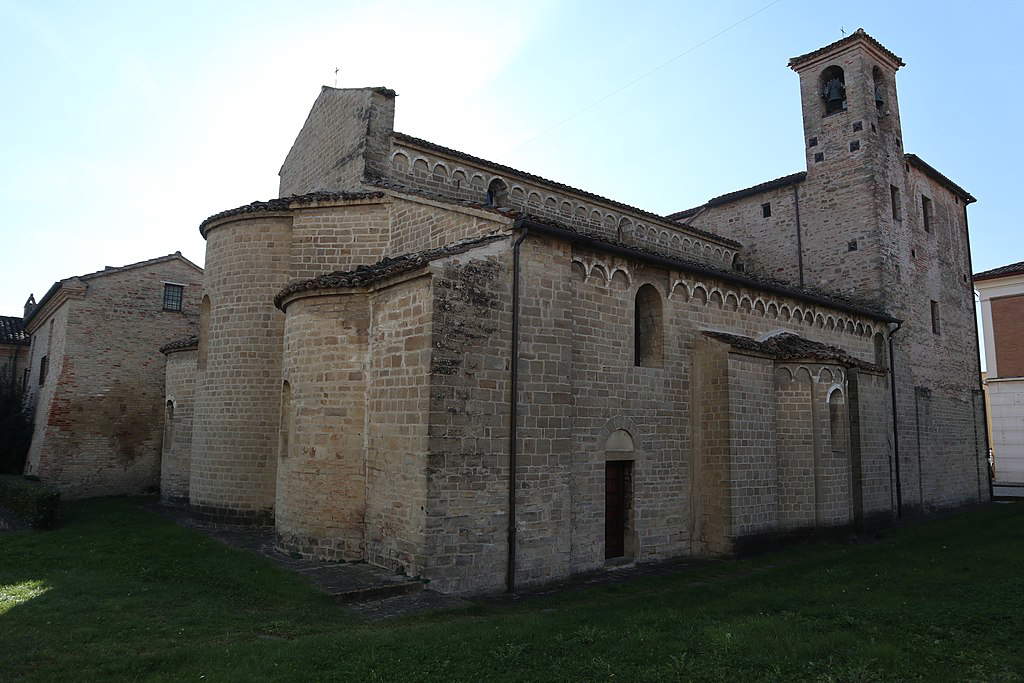 |
| Figure 1. Northeast view of the abbey of Santa Maria delle Moie. |
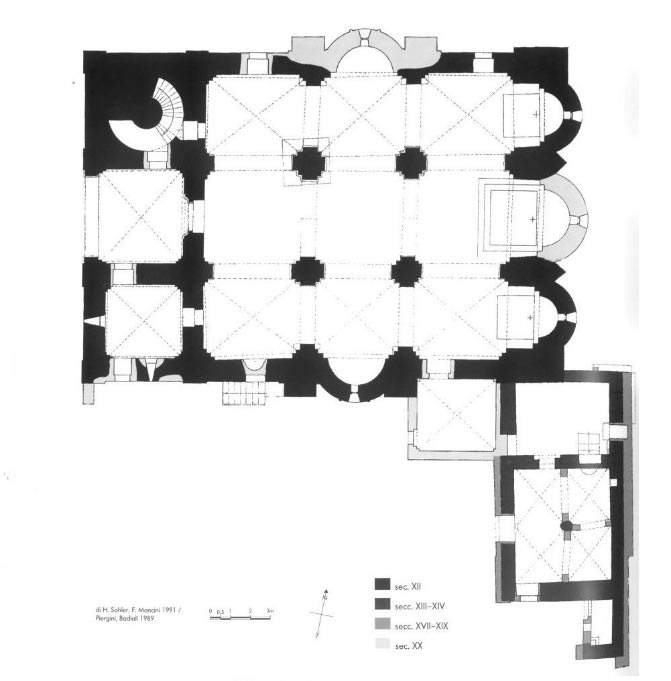 |
| Figure 2. Plan of the monastic complex showing construction phases. Drawing by H. Sahler, F. Mancini 1991 / Piergini, Badiali 1989 |
 |
| Figure 4. View of the church from the east |
 |
| Figure 5. View of the church from the south, photo by Alberto Monti |
The decoration on the north and south sides are different: on the north side the decorative frieze is found in the apse, under the eaves of the nave and side aisle (fig.1) while on the south side it is found only on the apse and side aisle (fig. 5). Labbazia also presents a western body in perfect connection with the trinaval laula: this part is the one that surely underwent the most profound changes. The best-preserved part is the lower part, divided into three zones by wide, flat pilasters, while the two-story upper part is made of brick (fig. 6).The church is entered through an outward-opening bay with a round arch.
The portal has a columned and stepped splay, decorated with interlacing of leaves and flowers (fig.7). Through the bay the north side can be accessed by a spiral staircase leading to the fairly low bell tower with round-arched openings, while in the southern part of the western body the room is cross-vaulted.
Internally in the south-facing side apse (fig.9) is a 16th-century wall painting of St. Anthony Abbot, suggesting a second altar dedicated to him. The saint is dressed in episcopal robes and sits on a throne flanked by two columns, with his left hand holding the crosier while his right hand blesses. To the left and right of his feet are represented the patrons, a woman and perhaps two bishops; in the background can be recognized isolated palm trees, a bell, a small black pig, and an ox. Unfortunately, the inscription running along the lower ornamental border is not legible.
Placed above the main altar is an 18th-century crucifix (fig. 8), while a panel depicting Mary and Child made by an anonymous painter in the 18th-19th centuries is located in the southeastern apse (fig.10). Our Lady of Mercy is highly venerated in the Vallesina and Marche regions, and this is evidenced by the fact that there are a variety of reproductions of it. As for the one in Santa Maria delle Moie, Sahler states that it shows similarities with the work by Giuseppe Azzi made in 1755 for the church of San Pietro Apostolo in Jesi, and the same scholar also points out strong affinities with a work by Luca Cranach the Elder preserved in Innsbruck.
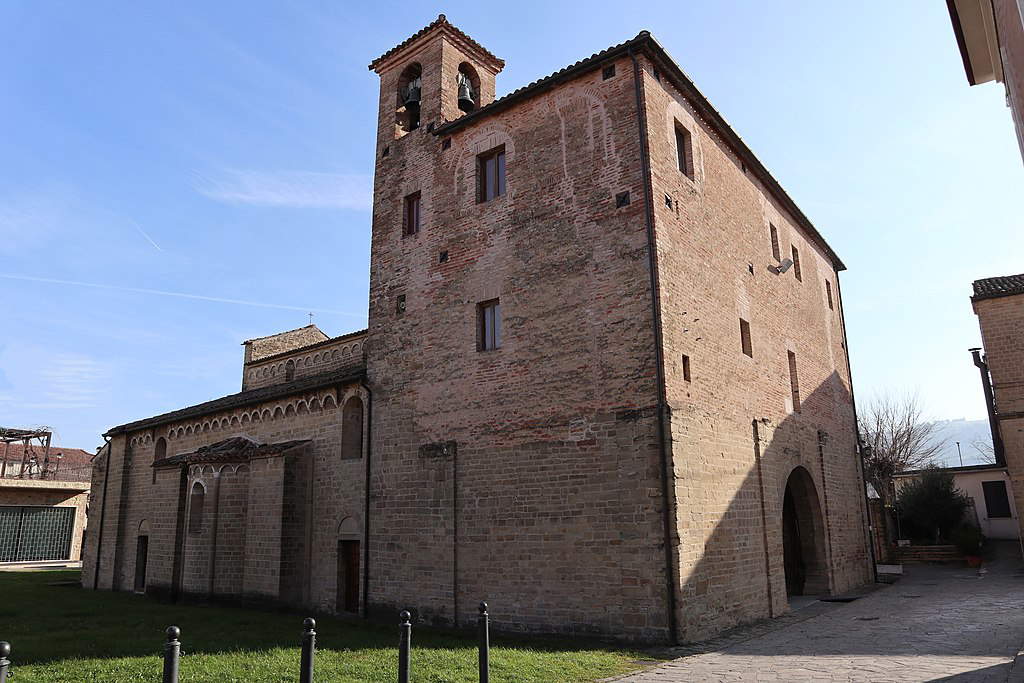 |
| Figure 6. Western side view of the church. |
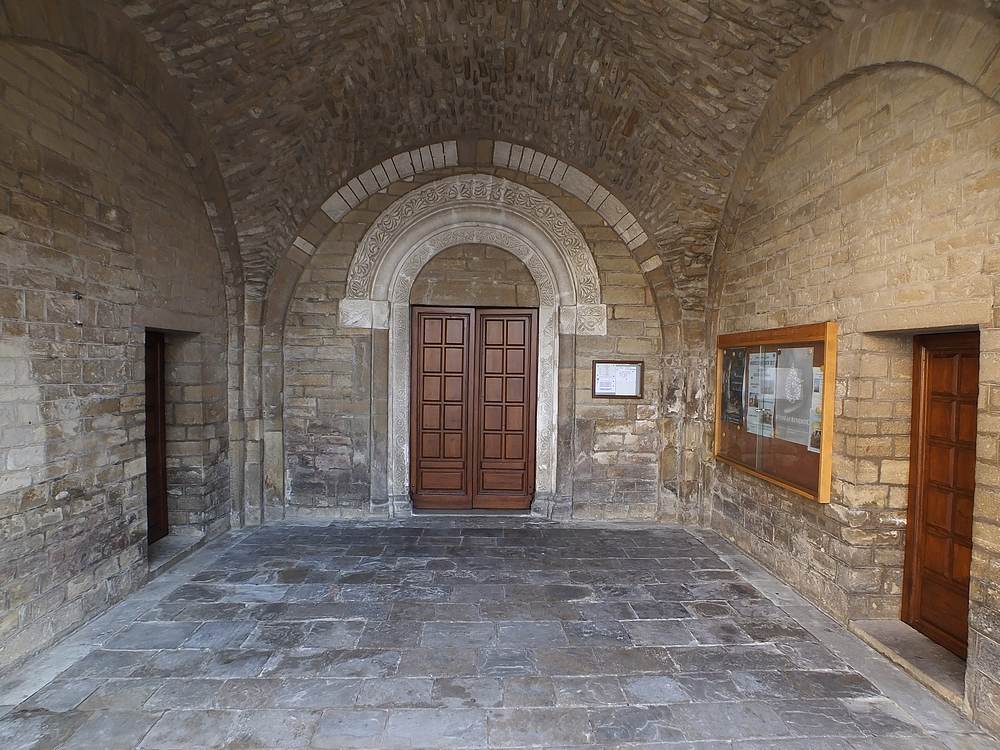 |
| Figure 7. Entrance span of the church, photo by Alberto Monti |
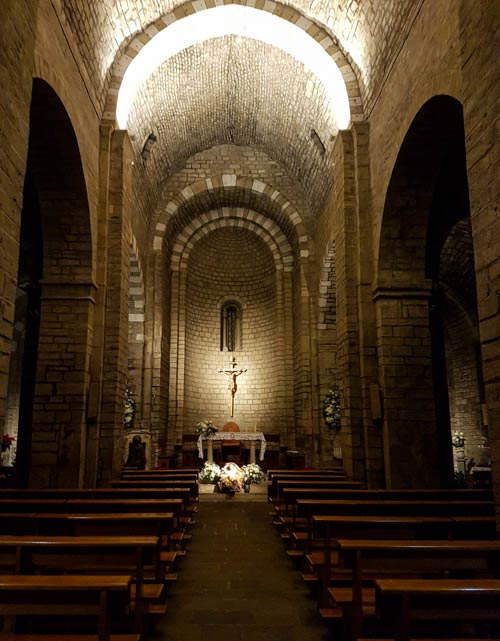 |
| Figure 8. Interior of the church: nave, source site www.viaggiesorrisi.com |
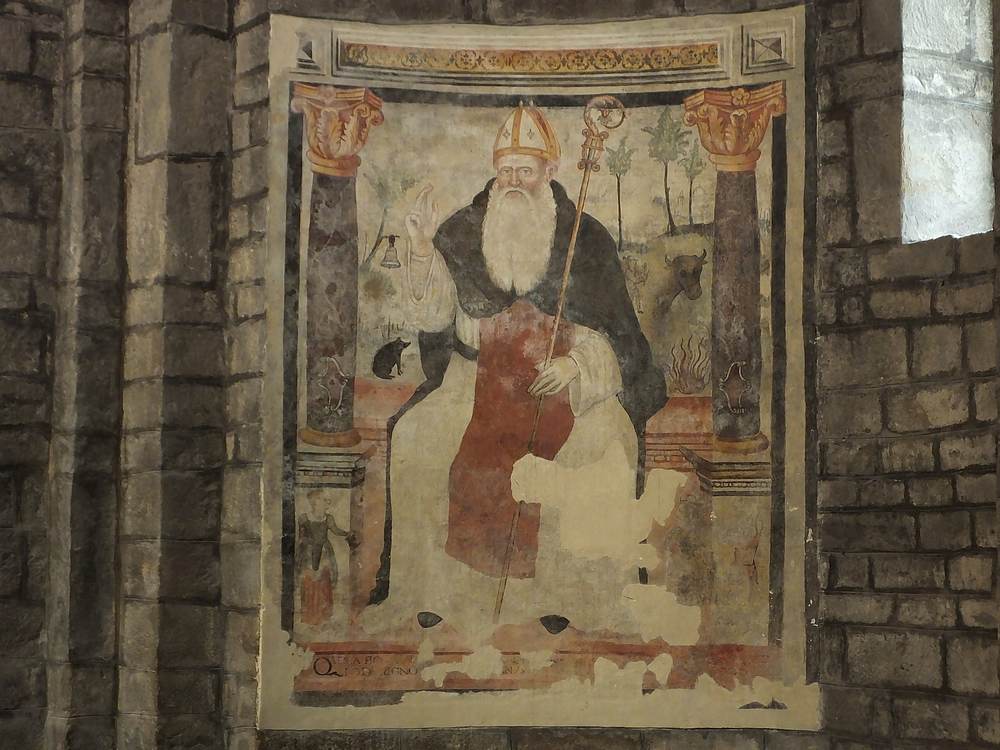 |
| Figure 9. Wall painting located in the south side apse, photo by Alberto Monti |
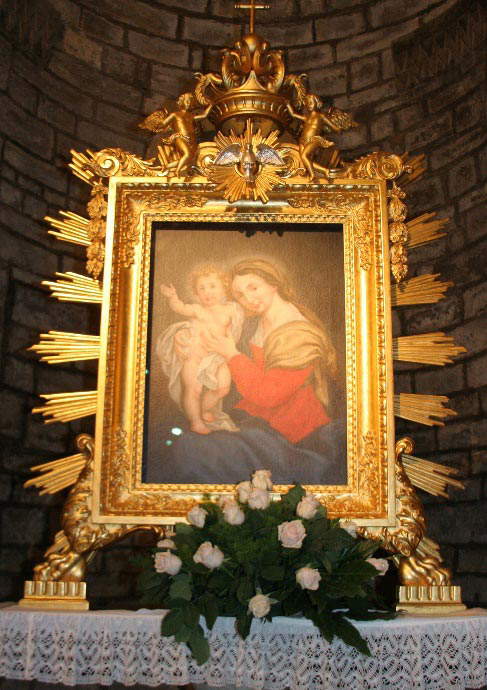 |
| Figure 10. Anonymous, Madonna of Mercy, 18th-19th century, source: site medieval Italy magazine |
Hildegard Sahler also carried out extensive studies to try to understand what the original appearance of the abbey was and the changes made in later centuries through graphic representations (figs. 3,11,12,13,16). Although the floor plan has almost been preserved in its original form, the western body as mentioned earlier is the one that has seen the most changes; it is believed that the medieval facade (fig.11) had two square towers corresponding to the aisles, not more than three stories high. Their appearance was the same as that of the tower of San Babila in Milan (fig.14): under the eaves ran perhaps a frieze of hanging arches stretched between the corner pilasters. Another frieze in the passage to the upper floor is to be assumed; the latter perhaps had mullioned openings. A similar window was located in the central part of the facade. As a termination of the facade, a spire similar to the eastern one can be reconstructed, perhaps embellished with a frieze of hanging arches.
The northwestern part has a scalaria tower from which one reached the women’s gallery and from this to the second floor of the southern tower, the upper floor of which could be reached by means of a ladder. The features of the elevation of Santa Maria di Moie (pseudo basilica and double tower facade) have important models in the region: for the pseudo basilica the then abbey church of Santa Maria di Portonovo near Ancona (fig.15). >The double-towered facade is of Farfesque derivation and is reminiscent of Bobbio Cathedral (fig. 16) and that in San Giacomo in Como. These patterns allow us to date the construction of thebabbey to the first decades of the 12th century.
In addition, Santa Maria, like the other churches in the inscribed Greek cross group, does not have load-bearing beams above the vaults but the spaces in between are filled with rubble, on top of which the tiles rest. For the model of the pointed barrel vault, the workers who worked in Moie looked to the nave of the church of SantUrbano allEsinante, a typology that spread to the Marche and Umbria regions. Concluding lanalysis of the characteristics of the plan, therefore, the influences of Germanic and French architecture mediated through the example of Farfa emerge, and probably also the presence of Lombard masters who appear in our region from the 12th century onward. The scholar H. Sahler hints at some Lombard contributions such as in the external decoration of thebothia, but, she argues that the masters were from the Marche region and had worked in the sites of SantUrbano, San Vittore, and Santa Croce dei Conti.
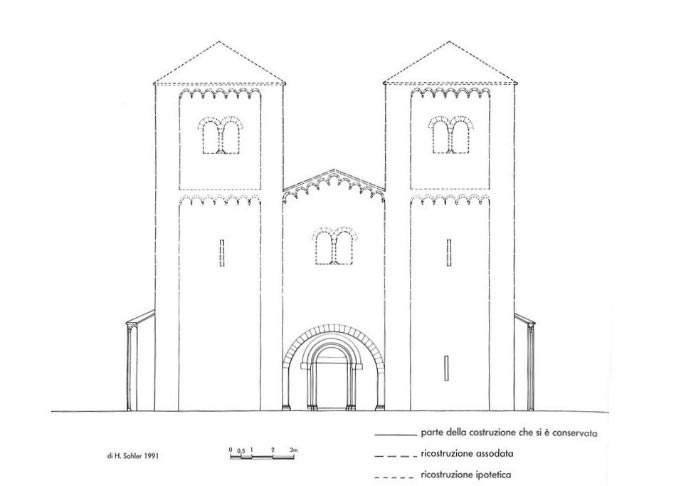 |
| Figure 11. Reconstruction of the western facade of the Romanesque church, drawing by H. Sahler 1991 |
 |
| Figure 12. North elevation of the church with indication of construction phases, drawing by H. Sahler 1991 based on drawings by Piergini, Badiali 1989 |
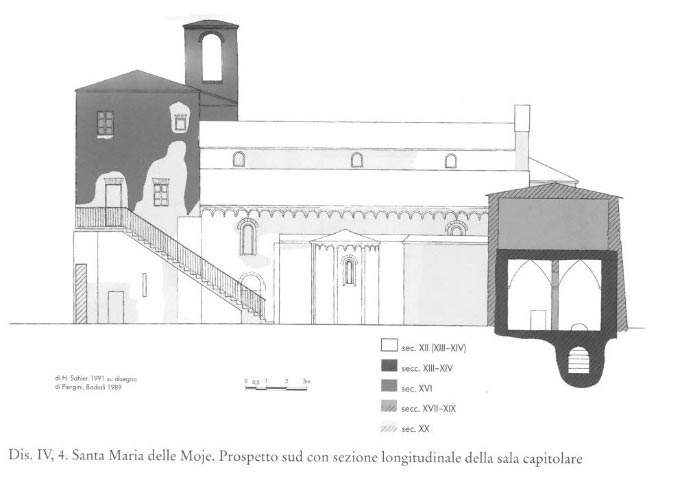 |
| Figure 13. South longitudinal section with indication of construction phases, drawing by H. Sahler, F. Mancini 1991 |
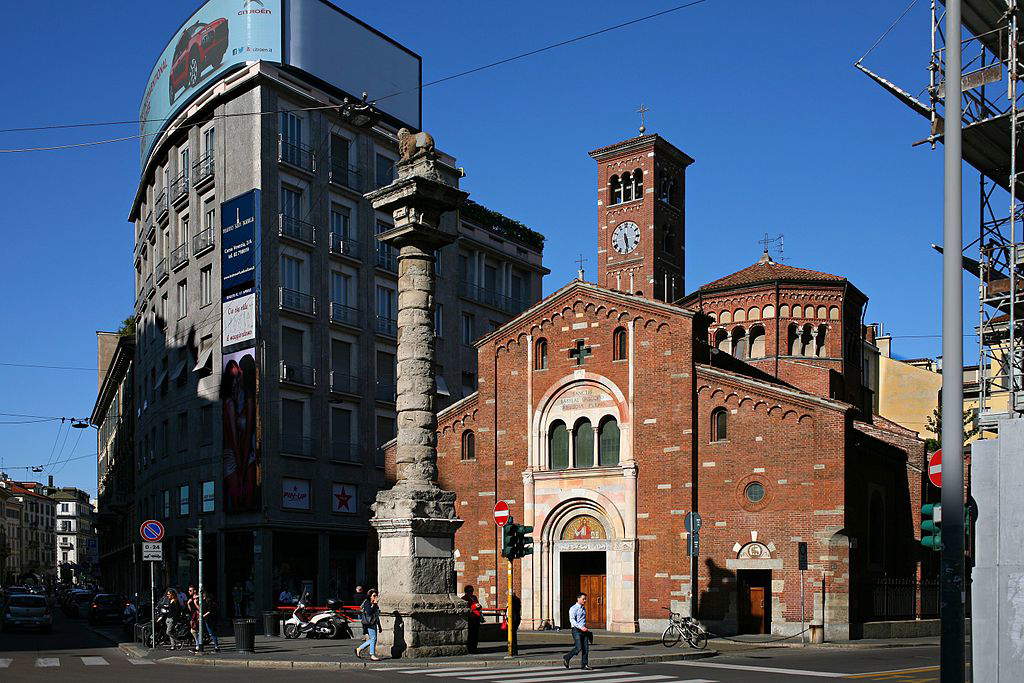 |
| Figure 14. Church of San Babila in Milan. Ph. Credit Paolo Bon |
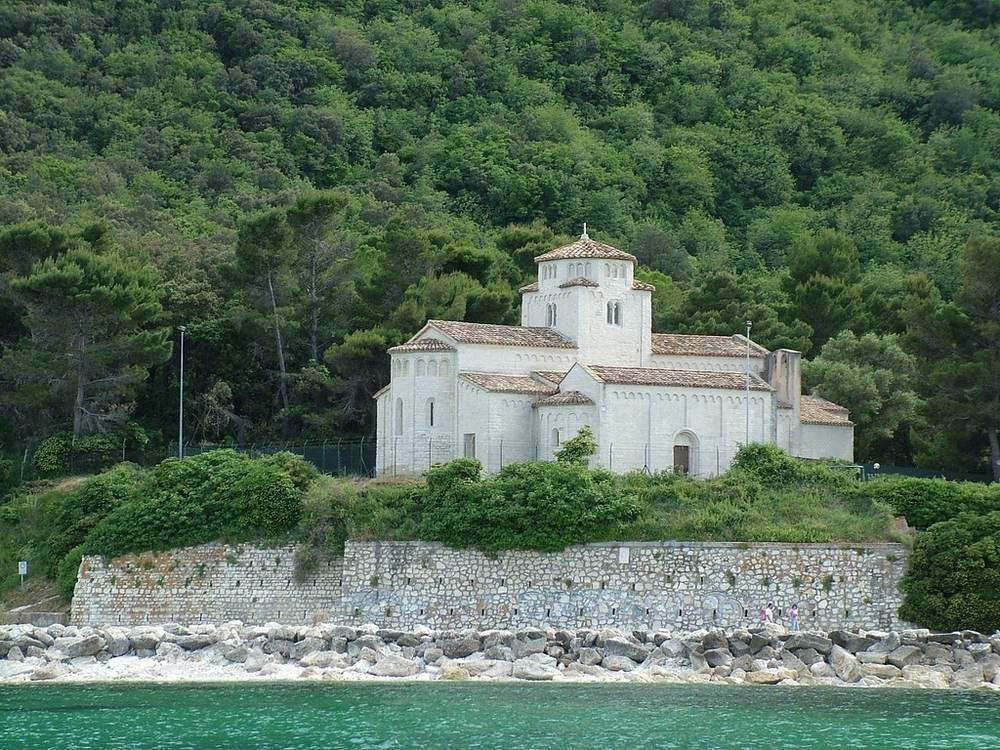 |
| Figure 15. Abbey of Santa Maria di Portonovo, photo by Alberto Monti. |
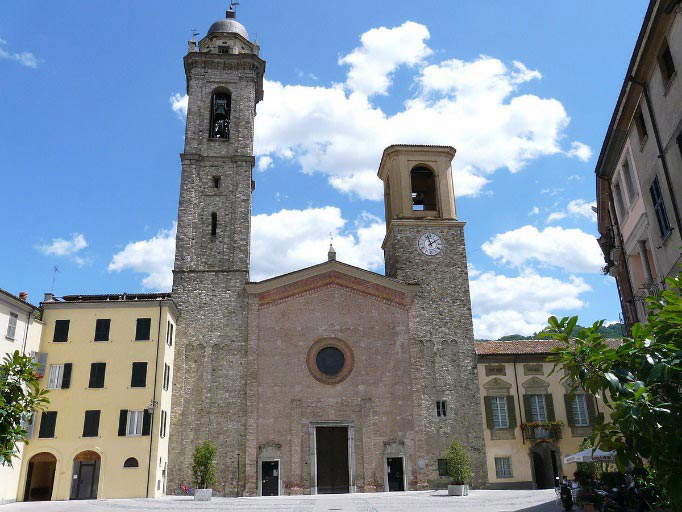 |
| Figure 16. Cathedral of Bobbio |
As for the convent buildings, all scholars agree that they were built after the church was completed, probably after the destruction of the castle of Moie in 1305 due to the war between Fabriano and Jesi. These buildings, in the course of time, were largely destroyed; only one brick-vaulted room built at the southeast corner of the church remained (figs. 17,19). This room was accessed through a doorway with a round arch that led up a steep staircase to a room with a cross vault that was perhaps the ancient chapter house; from this room there are three now-closed passages that connected with adjacent buildings, perhaps escape routes. The cloister of the Santa Maria di Moie abbey had three wings, one attached to the south side of the church and latra wing was a continuation of the western body to the south. The latest restoration dates back to 2010.
After having extensively described the appearance of the abbey in medieval times, it is also necessary to deal with the modifications and restorations carried out in later periods: the first certain restoration is from the 16th century, but it is necessary to mention what is claimed by some scholars, namely, that the present nave is not the one originally planned. If this claim is believed to be true one must backdate the first restoration to the 12th-13th centuries. On the façade and just above the entrance arch is a Latin epigraph placed at the point of transition from masonry to brick, which attests that Canon Girolamo I Isiler (mayor of the chapter of the Canons of Jesi and prothonotary apostolic) had the church restored following in the footsteps of his uncle Tommaso during the papacy of Clement VII in 1524 (fig.6). This restoration was probably necessary after a collapse of the western body and was exploited to carve out a priest’s quarters (representative of the Jesi cathedral chapter) on the upper floor. The work would follow the transfer of the land to the Jesi Cathedral Chapter: the opening of the women’s gallery was closed while in the last floor of the western body, on both sides of the edge of the northwest wall, and round arches were opened, suggesting a loggia, a common element in rural houses of the sharecropping.
A small bell tower was added to the north. The western body was divided into three floors. Of the two upper sixteenth-century ones, the first had a long barrel-vaulted hall, the second a series of rooms including the aforementioned loggia. The upper two floors were restored in the 18th century. Recall that in this century major restoration work was done by Bishop Ghislieri, who probably, thanks to his Marian devotion, had a canvas made depicting the Birth of the Virgin Mary and currently on display in the Diocesan Museum in Jesi. Between 1640 and 1650 the church came to be in an advanced state of decay probably as a result of the repeated flooding of the Esino, and in the 18th century the church was modernized in Baroque style partly as a result of the danger of collapse reported by Bishop Fonseca on his pastoral visit. In fact, the degraded and unsafe state of the walls and vaults near the high altar was reported. Three years later (1755) the waters of the Esino destroyed the commonsella (granary of the Chapter).
In 1788 the works initiated by Bishop Fonseca of Jesi involved the inversion of the entrance, which previously was to be located where the high altar currently stands, effectively walling off the current entrance. Reason for theinversion according to Sahler was the placement of the altarpiece dedicated to the Nativity of the Virgin, now at the Diocesan. Together the altar was also restored.
Between 1883 and 1886 further work was done: the central eastern apse was replaced by a straight wall with a modest Baroque portal (fig. 3). In front of the central portal was the high altar, and the wall was closed. It was rediscovered only by chance by a scholar, Gustavo Bevilacqua, who wrote an essay on the church. The former entrance bay had been converted into a sacristy, and to reach it there was a door on the ground floor of the scalaria tower and one to enter the southwest bay, as well as a door in the south wall of the same. The aisles were fitted with large windows. The loggia was also closed and a staircase added as an entrance to the habitation in the south side (fig.5).
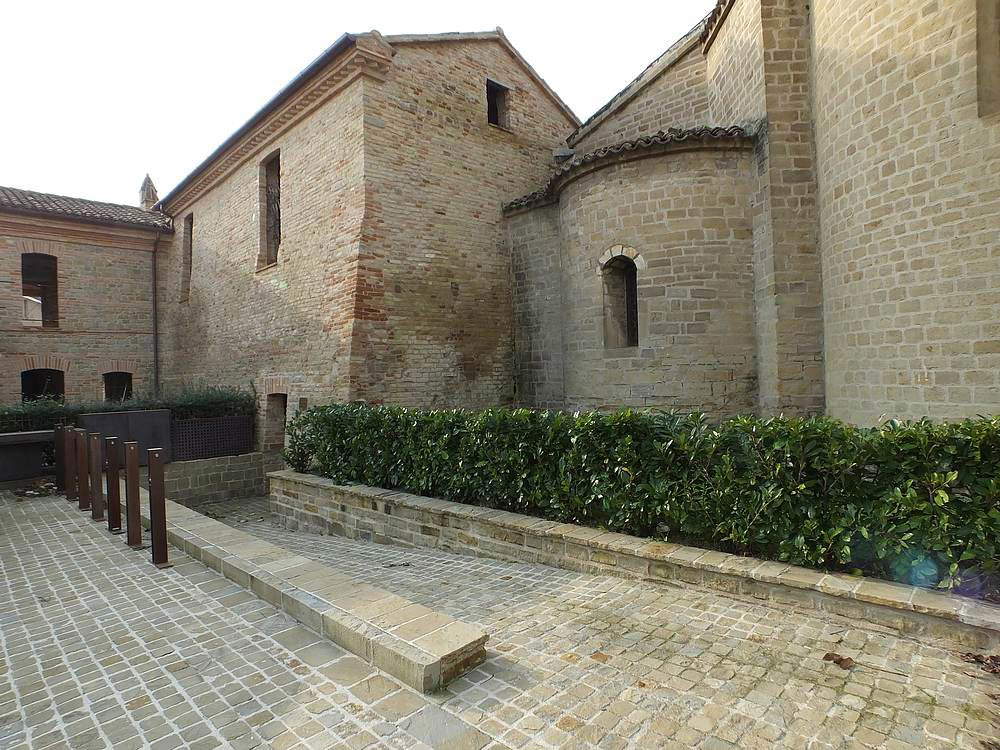 |
| Figure 17. View of the southeastern side of the church, photo by Alberto Monti |
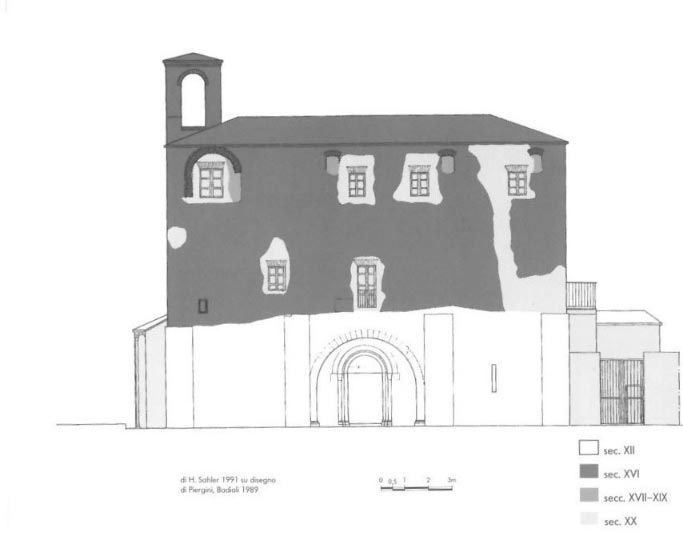 |
| Figure 18. Western facade with indication of construction phases, drawing by H.Sahler, F. Mancini 1991 |
 |
| Figure 19. Longitudinal section of the convent with indication of construction phases, drawing H.Sahler, F. Mancini 1991 |
Decidedly more challenging was the restoration of 1919-1924, begun by Superintendent Bocci and continued by Luigi Serra. The latter began by removing the eighteenth-century additions in the optic of returning to the origins, modern plasters and reconstructed medieval elements even where they were no longer preserved, had the medieval masonry imitated, reconstructed the central apse and part of the two adjoining ones, part of the hanging arches and part of the walls of the nave (figs. 3,4).
Serra’s project was very extensive but was not completely realized: the elevation was restored and integrated, the decoration of the north side was completed, the windows of the side aisles were reconstructed, a round-headed door present in the south side aisle was uncovered, in the western body the portal was opened after moving the altar, the damaged portal beam was fixed, the floor lowered 60 cm to the original level where the bases of the pillars appear. On this occasion a new altar with tabernacle was built in the central apse (figs. 3,12,13,18).
The entire restoration was problematic. With the lowering, graves were found. Unfortunately, no archaeological excavation was done during the various phases of restoration, so nothing is known about the earlier building and whether there were other altars. In the side aisles the two-color is present only in the arches of the eastern apses, in the transverse arches, and in the arches that are located further east. Then in 1988 the roofs of the church were renewed and the windows of the facade repaired with modern bricks. Lambone was executed in limestone and a bronze relief entitled Madonna of the Mission was affixed to it in 1966.
The last interventions carried out in theAbbey date from the period immediately following the 1997 earthquake that caused some damage. Anti-seismic improvement was provided with the insertion of tie rods in the first and second floors of the western body and in the bell tower (fig.1). Other areas were electrically repaired. Further work was also completed in 2004 following a fire in the left apse from the entrance, and efforts were made to restore the Romantic architecture to its essentiality.
Bibliography
Warning: the translation into English of the original Italian article was created using automatic tools. We undertake to review all articles, but we do not guarantee the total absence of inaccuracies in the translation due to the program. You can find the original by clicking on the ITA button. If you find any mistake,please contact us.